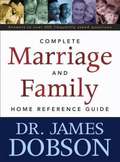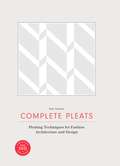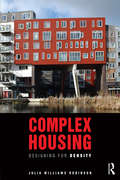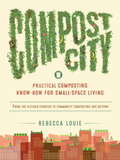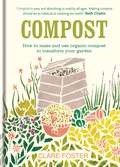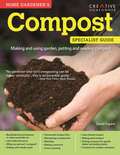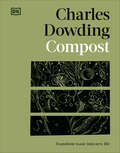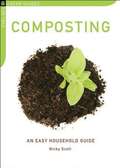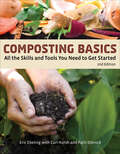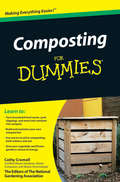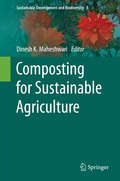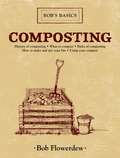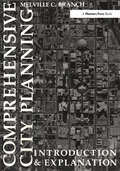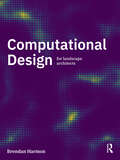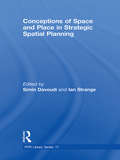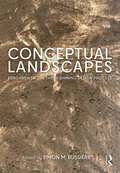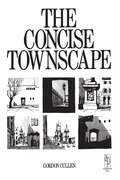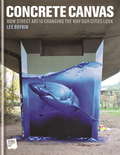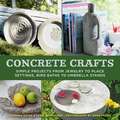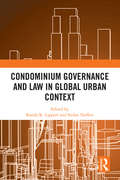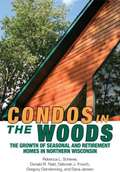- Table View
- List View
Complete Marriage and Family Homes Reference Guide
by Dr James DobsonThe Complete Marriage and Family Home Reference Guide by Dr. James Dobson, America's most respected expert on marriage, parenting, and the family. This comprehensive, easy-to-access resource offers time-tested, biblical based information to help build healthy, God-honoring families.
Complete Pleats: Pleating Techniques for Fashion, Architecture, Design
by Paul JacksonPaul Jackson‘s major new title Complete Pleats is the most comprehensive book about pleating on the market.It explains how pleating systems can be stretched, compressed, flared, skewed, multiplied, and mirrored, showing how from simple ideas, a huge number of original pleat forms can be created. Each technique is explained with a series of step-by-step photographs and line illustrations, enabling the designer to work through the basic principles of pleating and then adapt them to their specific needs. Complete Pleats also features more than 60 examples of pleats from the worlds of architecture, fashion, and product design.Paul Jackson has taught pleating techniques to students of Fashion Design for 30 years, in both paper and fabric. Complete Pleats is the definitive practical guide for anyone wishing to create and make pleats. The book includes a DVD featuring 23 videos of pleating techniques.
Complete Pleats: Pleating Techniques for Fashion, Architecture, Design
by Paul JacksonPaul Jackson‘s major new title Complete Pleats is the most comprehensive book about pleating on the market.It explains how pleating systems can be stretched, compressed, flared, skewed, multiplied, and mirrored, showing how from simple ideas, a huge number of original pleat forms can be created. Each technique is explained with a series of step-by-step photographs and line illustrations, enabling the designer to work through the basic principles of pleating and then adapt them to their specific needs. Complete Pleats also features more than 60 examples of pleats from the worlds of architecture, fashion, and product design.Paul Jackson has taught pleating techniques to students of Fashion Design for 30 years, in both paper and fabric. Complete Pleats is the definitive practical guide for anyone wishing to create and make pleats. The book includes a DVD featuring 23 videos of pleating techniques.
Complex Housing: Designing for Density
by Julia Williams RobinsonComplex Housing introduces an architectural type called complex housing, common to the Netherlands and found in other Northern European countries. Eight fully illustrated case studies show successful approaches to designing for density, which reflect values such as long-term planning, a right to housing, and access to light and air. The case studies demonstrate a wide range of applications including a mixture of urban and suburban sites, various numbers of dwelling units, low- to high-density approaches, different architectural styles, and organizational strategies that can be adopted in projects elsewhere. More than 350 color images.
Compost City: Practical Composting Know-How for Small-Space Living
by Rebecca LouieThese days, everyone's talking about compost.Along with backyard chickeners, balcony beekeepers, rooftop farmers, and community gardeners, urban composters are part of a bumper crop of pioneers who are redefining the green space of crowded towns and cities.You may think you need a big yard to compost. Think again. Compost City teaches you how to easily choose and care for a compost system that fits perfectly into your (tiny) space, (busy) schedule, and (multifaceted) lifestyle.Whether you live in a cramped apartment or a sprawling town house, or you dream of composting in a shared space with a group of friends or colleagues, Compost City provides simple and effective indoor and outdoor composting options.Packed with research, expert testimonies, and a healthy dose of humor, Compost City will help you: * compost your food scraps and yard waste with ease * ease your fears of backbreaking labor, obnoxious odors, big messes, and creepy crawlies (hint: you can compost successfully without any of the above!) * convince compost-wary family, friends, neighbors, and community leaders to green-light your compost dreamsCompost City serves all eco-curious citizens from casual hobbyists to staunch activists.Put your compost cap on. Whether you compost one tea bag or whole honking barrelfuls of scraps at a time, you're about to have a whole lot of fun.
Compost: How To Make And Use Organic Compost To Transform Your Garden
by Clare FosterIn this new edition of her hands-on guide to the art of composting, House & Garden garden editor, Clare Foster, shows you how to build a compost box, select the best ingredients and put the resulting organic compost to the best use in your outdoor space. By taking some dead leaves, grass cuttings and old banana skins and enlisting the help of bacteria, insects and nature, you can improve and enrich your soil, feed your plants and nourish your vegetables, restoring the natural balance of life in your garden.
Compost: How to make and use organic compost to transform your garden
by Clare FosterIn this new edition of her hands-on guide to the art of composting, House & Garden garden editor, Clare Foster, shows you how to build a compost box, select the best ingredients and put the resulting organic compost to the best use in your outdoor space.By taking some dead leaves, grass cuttings and old banana skins and enlisting the help of bacteria, insects and nature, you can improve and enrich your soil, feed your plants and nourish your vegetables, restoring the natural balance of life in your garden.
Compost: Making and using garden, potting, and seeding compost (Home Gardener's)
by David SquireA complete reference to making and using compost to reduce environmental impact and garden sustainably for beginning, veteran and organic gardeners. In recent times, people have become much more ecologically aware and also more keen to minimize their carbon footprint. This, coupled with the pressure from governments to recycle household waste, means that creating and using garden compost is becoming almost essential knowledge. This guide gives gardeners all the information they need about starting to make their own compost, storing it and using it. Information on different types of compost -- what they consist of, what they are good for and how they are best stored -- is given, before moving on to explore in detail how to create your own compost. Guidance is also given for those who wish to construct their own compost bin. There are specific chapters explaining wormeries and green manuring, as well as a wealth of information on seed and potting composts.
Compost: Transform Waste into New Life
by Charles DowdingLearn how to make compost gold from the master of healthy soil.Charles Dowding puts feeding the soil at the heart of his No Dig method of growing. He explains how to use your kitchen and garden waste to make homemade compost so that your plants can truly flourish.Discover what you can compost, how to get the perfect balance, and different ways to compost whatever your space with this beautiful, infallible guide.
Composting
by Nicky ScottA full-color guide for both beginners and experienced composters, with an A-Z reference section. Composting is fun, easy and very satisfying! You can make compost even if you live in an apartment or don't have access to a garden. There are lots of good reasons to make compost: bull; A third to two-thirds of the average garbage can contents can be composted, so you can lighten your bin-and stop it smelling. bull; Less organic material is sent to landfill, so less noxious liquids and greenhouse gases-especially methane-are produced. bull; Composting saves you money-you won't need to buy any more peat-based compost! This book will give you all the information you need for successful composting.
Composting Basics: All the Skills and Tools You Need to Get Started (How To Basics)
by Eric Ebeling Carl Hursch Patti OlenickFrom bin placement to vermicomposting, learn how to naturally recycle household waste—whether you live in the country, the suburbs, or the city. You don&’t need a science degree or a shed full of sophisticated equipment to make quality compost. What you need to get started is the know-how provided in this basic how-to book along a little elbow grease and the pile of organic materials you regularly throw away. Nature does the rest. Whether you live in a rural or urban home, whether you have a garden or not, you can recycle household waste in an environmentally friendly way and turn it into black gold: compost. You&’ll learn what and how to compost, how to make or buy bins, how to build a compost pile and make compost tea, and how to compost with worms. It&’s simple and easy to do, and the best part is that you&’ll be saving money and helping to save the earth as well.
Composting For Dummies
by The National Gardening Association Cathy CromellBack-to-basics gardening that will benefit the earth and your wallet! Want to use ordinary waste to create an extraordinary garden? Composting lets you turn household food waste, yard clippings, and more into free compost and mulch that's chock-full of nutrients. From building and working with traditional compost bins to starting an indoor worm-composting operation, Composting For Dummies makes these often intimidating projects easy, fun, and accessible for anyone! Digging into compost basics - get a handle on the benefits of composting and the tools you'll need to get started Choosing the best method and location - find the best composting method and location that's right for you, whether it's above ground, in a hole, in a container or bin, or even right in your kitchen Building your pile - learn which ingredients can go into your compost pile, what stays out, and how to mix it all up in the right proportions Stepping beyond traditional composting - get the lowdown on vermicomposting (letting worms eat your garbage), growing green manures to compost later, and sheet composting in the same spot you plan to plantOpen the book and find: A step-by-step guide to composting The right gear and tools for the job Tips on constructing your own composting containers and bins Materials you can safely compost (and those to avoid) Cover crops to improve your soil now and compost later Recommendations for using your finished compost What worms contribute to your compost Troubleshooting advice if your compost pile isn't cooperating Learn to: Turn household food waste, yard clippings, and more into nutrient-rich compost Build and maintain your own compost bin Use worms to aid in composting, both indoors and out Give your vegetable and flower gardens a boost of energy
Composting for Sustainable Agriculture (Sustainable Development and Biodiversity #3)
by Dinesh K. MaheshwariThe dramatic worldwide increase in agricultural and industrial productivity has created severe environmental problems. Soil and groundwater reservoirs have been polluted with pesticides, xenobiotics and agro-chemicals. The global consensus to reduce inputs of chemical pesticides and agrochemical fertilizers, which are perceived at being hazardous by some consumers, has provided opportunities for the development of novel, benign sustainable crop management strategies. The future of agricultural depends upon our ability to enhance the productivity without damage to their long-term production potential. One of the strategies is the application of effective microbial products beneficial for both farmers and ecosystems. This kind of approach can ensure both ecological and economic sustainability. Soil microbial populations are immersed in framework of interactions, which are known to affect plant fitness and soil quality. For betterment of life of human being, improved quality and variety of products are formed due to versatile action of different group of microorganisms, Microbes are able to degrade solid waste material into compost which is a mixture of decayed organic matter, manure etc. Incomplete microbial degradation of organic waste where the microbial process varies aerobic to anaerobic form is stated as compost, if added to soil improves plant growth and development. The biological activities and microbial metabolism in the soil contribute to alter its mixture and fertility. Incorporation of organic remain in the form of compost is known to influence favourably the physio-chemical and biological properties of soil. The beneficial activities bestowed upon plants by compost utilization are multifaceted, hence most promising alternatives for achieving sustainable agricultural production. An increased awareness on compost has led to their use in agricultural concern. Contents in the present book will comprised various chapters on the role of beneficial bacteria in the composting process. The application is depicted to achieve the attainable productivity besides, in disease management and suppressiveness of organisms of phytopathogenic in nature. Significance of the compost elicits certain responses e. g. soil reclamation, soil fertility, soil health and disease management exhibit due to quality compost amendment in soil. It serves as low cost prospective option for sustainable crop production and protection.
Composting: Bob's Basics (Bob's Basics)
by Bob FlowerdewThe best fertilizer for your organic garden is compost. It's easy to make, economically friendly, and teeming with nutrients. In this highly useful installment of his Bob's Basics series, Bob Flowerdew takes you through all the steps necessary to make a rich compost pile best suited to your needs. Composting is a highly comprehensive guide that goes over all the steps, from building a bin to collecting material to maintaining and adding to the finished product.
Compostology 1-2-3: Composting Made Simple
by Ethne ClarkeWant to compost but aren't sure where to start? Need a little help with a compost pile that's already in the garden? Compostology 1-2-3 is the answer! It's simply the best--and most complete--guide to successful composting for every garden size, and it answers the most-asked questions: What is compost? Why is it important? How do you make compost? And how do you use compost?The experts at Organic Gardening share their years of experience with composting, blending together how-to information and simple science to help backyard gardeners understand the process of transforming household and yard waste into rich, crumbly compost. Learn which materials make the best compost, how to build a compost bin or layer a compost pile, how to troubleshoot, which tools and supplies make the composting process easier, step-by-step methods to keep compost cooking, and how to use "gardener's gold" to enrich the soil in garden beds, planting areas, and container gardens. With helpful tips and hints and easy-to-understand illustrations, Compostology 1-2-3 shows how to make and use compost for better soil, healthier plants, and tastier vegetables and fruit. And it's as easy as 1-2-3.
Comprehensive City Planning: Introduction & Explanation
by Melville BranchThe author’s classic text focuses on the development of cities and how they have been planned and managed through the ages. The tie between land use and municipal administration is explored throughout. Topics include the roots of city management and planning; physical and socioeconomic views of cities; how city planning works within city government; the ties between planning and city politics; zoning and urban design; new towns; and regional planning. This work is the culmination of the author's long career in planning practice. His involvement in government, business, and academics means this book relates to a wide variety of fields. And the author writes in a clear, nontechnical style. Whether you're a city official, a professional, or a concerned citizen, you'll find this a cohesive, readable, and authoritative introduction to the field of planning.
Computational Design for Landscape Architects
by Brendan HarmonThis book is a guide to computational design for landscape architects replete with extensive tutorials. It introduces algorithmic approaches for modeling and designing landscapes. The aim of this book is to use algorithms to understand and design landscape as a generative system, i.e. to harness the processes that shape landscape to generate new forms. An algorithmic approach to design is gently introduced through visual programming with Grasshopper, before more advanced methods are taught in Python, a high-level programming language. Topics covered include parametric design, randomness and noise, waves and attractors, lidar, drone photogrammetry, point cloud modeling, terrain modeling, earthworks, digital fabrication, and more. The chapters include sections on theory, methods, and either visual programming or scripting. Online resources for the book include code and datasets so that readers can easily follow along and try out the methods presented. This book is a much-needed guide, both theoretical and practical, on computational design for students, educators, and practitioners of landscape architecture.
Conceptions of Space and Place in Strategic Spatial Planning (RTPI Library Series)
by Ian Strange Simin DavoudiBringing together authors from academia and practice, this book examines spatial planning at different places throughout the British Isles. Six illustrative case studies of practice examine which conceptions of space and place have been articulated, presented and visualized through the production of spatial strategies. Ranging from a large conurbation (London) to regional (Yorkshire and Humber) and national levels, the case studies give a rounded and grounded view of the physical results and the theory behind them. While there is widespread support for re-orienting planning towards space and place, there has been little common understanding about what constitutes ‘spatial planning’, and what conceptions of space and place underpin it. This book addresses these questions and stimulates debate and critical thinking about space and place among academic and professional planners.
Conceptual Landscapes: Fundamentals in the Beginning Design Process
by Simon M. BussiereConceptual Landscapes explores the dilemma faced in the early moments of design thinking through a gradient of work in landscape and environmental design media by both emerging and well-established designers and educators of landscape architecture. It questions where and, more importantly, how the process of design starts. The book deconstructs the steps of conceptualizing design in order to reignite pedagogical discussions about timing and design fundamentals, and to reveal how the spark of an idea happens – from a range of unique perspectives. Through a careful arrangement of visual essays that integrate analog, digital, and mixed-media works and processes, the book highlights differences between diverse techniques and triggers debate between design, representation, technology, and creative culture in the field. Taken together, the book’s visual investigation of the conceptual design process serves as a learning tool for aspiring designers and seasoned professionals alike. By situating student work alongside that of experienced teachers and landscape architects, the book also demystifies outdated notions of individual genius and sheds new light on the nearly universally messy process of discovery, bridged across years and diverse creative vocabularies in the conceptual design process. Lavishly illustrated with over 210 full color images, this book is a must-read for students and instructors in landscape architecture.
Concise Townscape
by Gordon CullenThis book pioneered the concept of townscape. 'Townscape' is the art of giving visual coherence and organization to the jumble of buildings, streets and space that make up the urban environment. It has been a major influence on architects, planners and others concerned with what cities should look like.
Concrete Canvas: How Street Art Is Changing the Way Our Cities Look
by Dr Lee BofkinWhat happens when you look at graffiti and street art as unlimited art forms instead of urban phenomena? Concrete Canvas does just that; investigating the media the artists work with, the canvases they work on, the themes that arise through their work, and the way their art redefines the spaces in which it is set.Concrete Canvas is filled with stunning photos of works from new and exciting artists, as well as established names, including Ron English, Phlegm, Daim, Invader and more. It examines how the curation of public space is affecting our cities and moving art into the future. Global Street Art is the largest online archive of street art photography. Here, its founder Lee Bofkin shares some of his best stories of documenting street art, which variously feature big guns, massive dogs and lots of abandoned buildings.
Concrete Crafts: Simple Projects from Jewelry to Place Settings, Birdbaths to Umbrella Stands
by Sania Hedengren Susanna Zacke Anna SkoogPouring concrete doesn't have to be left to the professionals-decorate your home with concrete poured, mixed, and molded by your own two hands! Versatile, inexpensive, and easily casted, concrete is the perfect medium for crafters, tinkerers, and home improvers. Now, lifelong crafters and interior designers Susanna Zacke and Sania Hedengren reveal more than thirty of their favorite, no-fuss casting projects.Decorate your kitchen table or outdoor patio with: Rhubarb leaf fruit bowls Clustered candleholders Birdbaths Patterned pots Flower vases Angel figurines And much more!Once you get started, you won't want to stop making trinkets and ornate arrangements for friends, family, and each room in your house. Plus, crafting with concrete is a great way to get outside and enjoy a beautiful, sunny day.Featuring step-by-step photos, easy-to-follow directions, and Susanna and Sania's expert tips, Concrete, the Perfect Hobby is the ultimate new guide to outdoor crafting. Pour out your creativity and discover the beautiful, practical items you can cast!
Concrete Garden Projects: Easy & Inexpensive Containers, Furniture, Water Features & More
by Camilla Arvidsson Malin NilssonFor gardeners and backyard do-it-yourselfers, concrete is a revelation. It's durable, weatherproof, impossible to steal, and it provides much-needed insulation for outdoor plants. Concrete weathers beautifully, softening around the edges, developing moss, and becoming more picturesque with age.Concrete Garden Projects takes advantage of concrete's numerous assets, showcasing an inspiring array of creative options. The step-by-step instructions for dozens of easy, do-it-yourself décor ideas include containers of all shapes and sizes, elegant benches and stools, miniature ponds and birdbaths, stepping stones, a barbecue, and a fire pit. The authors use a variety of molds easily found or made, household items like bowls and baking pans, and simple wooden frames and boxes. At pennies per pound, and so simple to use—just mix with water and pour—concrete is the key to hand-crafted backyard décor.
Condominium Governance and Law in Global Urban Context
by Randy K. Lippert; Stefan TreffersThis book examines condominium, property, governance, and law in international and conceptual perspective and reveals this urban realm as complex and mutating. Condominiums are proliferating the world over and transforming the socio-spatial organization of cities and residential life. The collection assembles arguably the most prominent scholars in the world currently working in this broad area and situated in multiple disciplines, including legal and socio-legal studies, political science, public administration, and sociology. Their analyses span condominium governance and law on five continents and in nine countries: the United States (US), China, Australia, the United Kingdom (UK), Canada, South Africa, Israel, Denmark, and Spain. Neglected issues and emerging trends related to condominium governance and law in cities from Tel Aviv to Chicago to Melbourne are discerned and analysed. The book pursues fresh empirical inquiries and cogent conceptual engagements regarding how condominiums are governed through law and other means. It includes accounts of a wide range of governance difficulties including chronic anti-social owner behaviour, short-term rentals, and even the COVID-19 pandemic, and how they are being dealt with. By uncovering crucial cross-national commonalities, the book reveals the global urban context of condominium governance and law as empirically rich and conceptually fruitful. The book will appeal to researchers and students in socio-legal studies, law, sociology, political science, urban studies, and public administration as well as journalists, social activists, policymakers, and condo owners/board members.
Condos in the Woods
by Rebecca L. ScheweScenic rural communities across the nation and around the world have been transformed as they have shifted away from extractive industries such as agriculture, mining, and forestry and toward recreation-based development relying on tourism, vacation homes, and retirees. These communities have built new economies and identities based on local natural resources and are highly dependent on the natural environment. With these changes have come new questions: Do retirees and seasonal residents fit into their new surroundings? Do longtime and new residents share the same values and visions for the future? Do diverse community members disagree about how to manage their forest and water resources? Condos in the Woodsexplores how these issues are reshaping community structure, employment, and inhabitants’ attitudes toward their environment in the Northwoods. Looking at trends from the 1970s to the present, this work moves from the national scale to the Pine Barrens region in northwestern Wisconsin and examines the approaches of residents to the management of their natural resources. At the heart of this story, the authors find that despite the diverse makeup of such communities, residents share many common goals and values and display more successful integration than previously expected.
